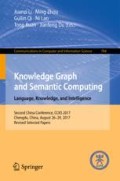Abstract
Recently, tenors have been widely used to encode triples in an RDF graph, which is sometimes called a knowledge graph, for the purpose of knowledge completion and embedding. An interesting question is, can we use tensors to represent OWL ontologies, and handle logical reasoning with ontologies by tensor operations. In this paper, we take the first effort to theoretically build the connection between tensor-based representation and a Horn fragment of OWL, Horn-\(\mathcal {SHOIQ}\), i.e., to study how to encode Horn-\(\mathcal {SHOIQ}\) ontologies to tensors, and further consider using tensor operations to handle ontology materialization, which is an important logical reasoning service for ontology-based applications. We show that the soundness and completeness of ontology materialization can be guaranteed by using tensor operations.
Access this chapter
Tax calculation will be finalised at checkout
Purchases are for personal use only
Notes
- 1.
- 2.
- 3.
- 4.
Here, we use ‘\(\ge \)1’ to include the situations where redundant occurs. Specifically, if \(\tau (\alpha )\) occurs as an addend in \(\varPhi ^i(\mathfrak {O})\) more than once, it can be checked that \(\varPhi ^i(\mathfrak {O})\bullet \tau (\alpha )\ge 1\).
References
Baader, F., Calvanese, D., McGuinness, D.L., Nardi, D., Patel-Schneider, P.F.: The Description Logic Handbook: Theory, Implementation and Applications. Cambridge University Press, Cambridge (2003)
Bordes, A., Usunier, N., García-Durán, A., Weston, J., Yakhnenko, O.: Translating embeddings for modeling multi-relational data. In: Proceedings of NIPS, pp. 2787–2795 (2013)
Bordes, A., Weston, J., Collobert, R., Bengio, Y.: Learning structured embeddings of knowledge bases. In: Proceedings of AAAI (2011)
Carral, D., Feier, C., Grau, B.C., Hitzler, P., Horrocks, I.: Pushing the boundaries of tractable ontology reasoning. In: Mika, P., et al. (eds.) ISWC 2014. LNCS, vol. 8797, pp. 148–163. Springer, Cham (2014). https://doi.org/10.1007/978-3-319-11915-1_10
Chang, K., Yih, W., Yang, B., Meek, C.: Typed tensor decomposition of knowledge bases for relation extraction. In Proceedings of EMNLP, pp. 1568–1579 (2014)
Grefenstette, E.: Towards a formal distributional semantics: simulating logical calculi with tensors. CoRR (2013)
Kolda, T.G., Bader, B.W.: Tensor Decompositions and Applications. Sandia National Laboratories, Albuquerque (2007)
Lee, M., He, X., Yih, W., Gao, J., Deng, L., Smolensky, P.: Reasoning in vector space: an exploratory study of question answering. CoRR (2015)
Rocktäschel, T., Bosnjak, M., Singh, S., Riedel, S.: Low-dimensional embeddings of logic. In: Proceedings of ACL Workshop on Semantic Parsing, pp. 45–49 (2014)
Smolensky, P.: Tensor product variable binding and the representation of symbolic structures in connectionist systems. J. Artif. Intell. 46(1–2), 159–216 (1990)
Smolensky, P., Lee, M., He, X., Yih, W., Gao, J., Deng, L.: Basic reasoning with tensor product representations. CoRR (2016)
Socher, R., Chen, D., Manning, C.D., Ng, A.Y.: Reasoning with neural tensor networks for knowledge base completion. In: Proceedings of NIPS, pp. 926–934 (2013)
Wang, Q., Wang, B., Guo, L.: Knowledge base completion using embeddings and rules. In Proceedings of IJCAI, pp. 1859–1866 (2015)
Author information
Authors and Affiliations
Corresponding author
Editor information
Editors and Affiliations
Rights and permissions
Copyright information
© 2017 Springer Nature Singapore Pte Ltd.
About this paper
Cite this paper
Zhou, Z. (2017). Tensor-Based Representation and Reasoning of Horn-\(\mathcal {SHOIQ}\) Ontologies. In: Li, J., Zhou, M., Qi, G., Lao, N., Ruan, T., Du, J. (eds) Knowledge Graph and Semantic Computing. Language, Knowledge, and Intelligence. CCKS 2017. Communications in Computer and Information Science, vol 784. Springer, Singapore. https://doi.org/10.1007/978-981-10-7359-5_4
Download citation
DOI: https://doi.org/10.1007/978-981-10-7359-5_4
Published:
Publisher Name: Springer, Singapore
Print ISBN: 978-981-10-7358-8
Online ISBN: 978-981-10-7359-5
eBook Packages: Computer ScienceComputer Science (R0)

